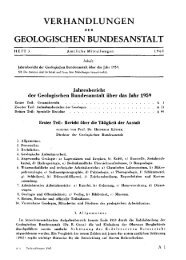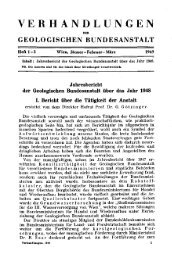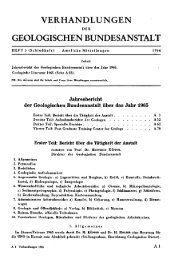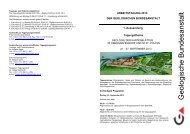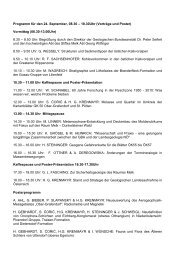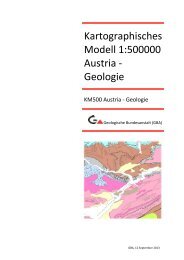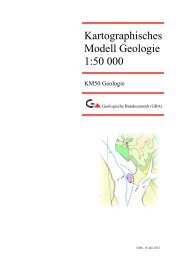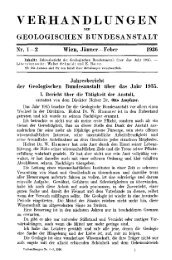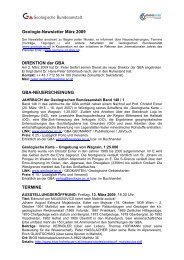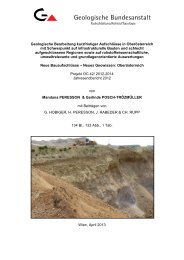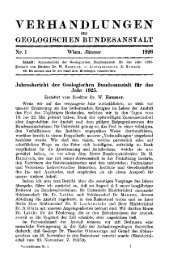Field Trip B TRIASSIC CONODONT LOCALITIES OF THE ...
Field Trip B TRIASSIC CONODONT LOCALITIES OF THE ...
Field Trip B TRIASSIC CONODONT LOCALITIES OF THE ...
You also want an ePaper? Increase the reach of your titles
YUMPU automatically turns print PDFs into web optimized ePapers that Google loves.
The Salzkammergut and its geological setting within the Northern Calcareous Alps<br />
By<br />
B. PLÖCHINGER (Geological Survey of Austria)<br />
A short introduction describes the geology of the Northern Calcareous Alps (N. C. A.) and the tectonic<br />
position of the Salzkammergut area situated in the central part (figs. 1, 2). Fig. 3 summarizes the<br />
stratigraphy of the N. C. A. with special reference to the Hallstatt facies development which will be<br />
shown during the excursion.<br />
The Northern Calcareous Alps form a zone 500 km in length and 40—50 km wide, situated between<br />
the Central Alps and the Grauwacken Zone in the south and the Flysch and Molasse Zones in the north<br />
(fig. 1). The Permomesozoic series of the N. C. A. were deposited in an Austroalpine realm formerly si<br />
tuated south of the Penninic realm; rocks of the latter are now culminating in the Hohe Tauern mountain<br />
range. In the Cretaceous and early Tertiary the N. C. A. and the underlying Paleozoic Grauwacken<br />
Zone were sheared off from the crystalline basement and thrust towards^ north. Consequently, no basement<br />
rocks can be found underneath the Grauwacken Zone which in turn is only partly preserved along<br />
the southern margin of the N. C. A.<br />
During the Triassic and Jurassic early crustal movements occurred. The movements of Jurassic (Younger<br />
Kimmeridge Phase) and Lower Cretaceous (pre-Austrian or Austroalpine Phase) may have increased<br />
submarine salt diapirism and with it the formation of submarine ridges with Hallstatt facies. These ridges<br />
are responsible for the formation of olisthostrbmeswith components of Hallstatt facies and olistholites<br />
of Hallstatt facies.<br />
Cenomanian sediments of the Northern Calcareous Limestone realm transgressed after intense folding<br />
and formation of slices during the pre-Cenomanian Austric Phase. The Gosau Formation disconformably<br />
overlies slices and nappes of pre-Coniacian age. During the Senonian and Lower Tertiary the<br />
nappe transport towards north continued. These movements reached a climax during the Lower Tertiary<br />
Illyric-Pyrenaic Phase orPyrenaic-Savic Phase in an en bloc northerly thrust of the calcalpine nappe<br />
pile onto the Flysch and Helvetic Zones. An excellent example illustrates this situation in the tectonic<br />
Window of Lake Wolfgang (Province of Salzburg) where along thrust planes rocks of the basalmost<br />
Ultrahelveticum and those of the Flysch Zone are exposed within the Northern Calcareous Alps.<br />
During the Upper Tertiary the old thrust planes were rejuvenated and formation of slices and folding<br />
reoccurred. This was the time when the present day exposed N. C. A. became a mountain chain.<br />
The Salzkammergut of Salzburg, Upper Austria, and Styria, with its famous salt mines, is part of<br />
the central section of the N. C. A. There the nappes of the tectonically lower „Bajuvaricum" are reduced<br />
by the far to the north reaching „Tyrolicum", a higher tectonic unit („Tirolischer Vorstoß of Staufen-Höllengebirgsdecke").<br />
Within the Tyrolicum, forming a huge synform, the „Lower Juvavicum" (Hallstatt zones and Hallstatt<br />
Deckschollen with their distinct facies), and the „Upper Juvavicum" (Berchtesgaden or Reiteralm<br />
nappe and Dachstein nappe, both supposed to be transported over long distances towards the north)<br />
are embedded.<br />
According to J. NOWAK (1911), F. F. HAHN (1913) and E. SPENGLER (since 1914) the Hallstatt<br />
outliers originated south of the realm of the Dachstein Limestone, i. e., south of the higher Juvavic<br />
Dachstein massif. In contradiction, E. HAUG (1908) placed the roots of these outliers between the<br />
Toten Gebirge nappe and the Dachstein nappe. This idea was followed by L. KOBER (1927), W. MED-<br />
WENITSCH (since 1949), A. TOLLMANN (since 1960), L. KRYSTYN & W. SCHÖLLNBERGER<br />
(1972), U. PISTOTNIK (1975).<br />
Following E. MOJSISOVICS (1903) modern geologists assume channel like Hallstatt throughs („Hallstätter<br />
Kanäle") which are located between the sedimentation areas of Hauptdolomite, Dachstein Lst.<br />
and Dachstein reef limestone, e. g., in the Zlambach-Grundlsee area of the Upper Austrian — Styrian<br />
Salzkammergut (Zlambach unit), in the zone of Torrener Joch—Lammer valley—Zwieselalm area (Lämmer<br />
unit), on the southern side of the Dachstein massif, in the Mandling slice, and in the Bliihnbach valley<br />
(H. ZANKL 1962, 1967; V. HÖCK & W. SCHLAGER 1964; W. SCHLAGER 1967, A. TOLLMANN<br />
1976, R. LEIN 1976). The existence of the Sandling nappe of A. TOLLMANN, previously described<br />
as upper Hallstatt nappe and derived from the southern Hallstatt channel, however, is more and more<br />
doubted because of the interfingering of rocks of basinal and ridge facies (G. SCHÄFFER 1973, 1976,<br />
U. PISTOTNIK 1974). The mechanism of intra-Jurassic emplacement of the Lammer unit is still under<br />
discussion.<br />
62



